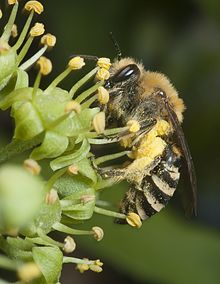Ivy silk bee
| Ivy silk bee | ||||||||||||
|---|---|---|---|---|---|---|---|---|---|---|---|---|

Ivy silk bee ( Colletes hederae ) male |
||||||||||||
| Systematics | ||||||||||||
|
||||||||||||
| Scientific name | ||||||||||||
| Colletes hederae | ||||||||||||
| K. Schmidt & Westrich , 1993 |
The ivy silk bee ( Colletes hederae ) is a species of the silk bee genus . Despite its conspicuous appearance and its occurrence in Central Europe , which has been very well researched in the faunistic sense , it remained undiscovered for a long time and has only recently been described as an independent species (Schmidt & Westrich 1993).
features
In appearance, the ivy silk bee is very similar to the closely related heather silk bee ( Colletes succinctus ) and even more closely to the salt silk bee ( Colletes halophilus ) living on the coast . The female is on average 13, the male 10 mm tall and thus significantly larger than the heather silk bee. The breast is covered in dense yellow-brown hair, the abdomen has broad, continuous bands at the ends of the abdominal rings, which are yellow-brown in color in fresh animals, in contrast to the whitish coloration in the salt silk bee. Another distinguishing feature of this species is the weaker puncture on the second abdominal ring.
Way of life
The most striking characteristic of this bee, from which it owes its name, is its specialization in ivy pollen as larval food. Typical visitors to ivy flowers include wasps and hoverflies at most, honey bees , but hardly any other bees. Because of the late blooming time of the ivy, the ivy silk bee appears quite late in the year, from September, and sometimes even into November. She is one of the latest voices in Central Europe. The nests are created in the ground, ideal nesting sites are loess walls . Under favorable climatic conditions and with a rich vegetation of ivy plants, a mass occurrence of the ivy silk bee can occasionally be observed (Schmid-Egger 1997).
distribution
The distribution area has not yet been thoroughly researched, so far the species has been found from Spain, the Netherlands, Great Britain and France in the west via Germany and Switzerland to Croatia. In Germany, the distribution is concentrated in the Upper Rhine Plain and the Middle Rhine as well as the adjacent Moselle valley.
In 2006, a significant wave of this type was observed in Germany and northern Switzerland. Many of the finds come from regions in which they have not been detected before. It is noteworthy that most of the newly found nesting sites for the ivy silk bee are in kindergarten sandboxes. An occurrence there in earlier years is considered to be excluded, which means that a real area expansion can be concluded.
discovery
It may come as a surprise that this striking species was not discovered earlier. The main reason is that all earlier finds were mistaken for the very similar heather silk bee or the salt silk bee, the deviations in flower visits were either overlooked or were not given great importance. Further reasons are to be seen in the fact that usually neither during the flight time of the ivy silk bee nor on its forage plant is intensively researched for stings. In addition, the species is apparently only very locally distributed in Central Europe.
The first indications emerged from systematic studies of the pollen loads. The discovery of ivy pollen was initially interpreted as switching to another forage plant when there was a lack of food. However, observations of the flower visit of the supposed heather silk bees and the above-average size of the animals led to the assumption that it was a previously undetected species.
literature
- Konrad Schmidt, Paul Westrich: Colletes hederae n. Sp., A previously unrecognized type of bee (Hymenoptera: Apoidea) that specializes in ivy (Hedera). In: Entomological Journal. Volume 103, No. 6, 1983, ISSN 0013-8843 , pp. 89-112.
- Christian Schmid-Egger: Mass appearance of Colletes hederae. In: bembiX. Volume 9, 1997, pp. 16-17 ( booklet as PDF file; 2.85 MB ).
- Paul Westrich: Flexible pollen collecting behavior of the otherwise strictly oligolectic silk bee Colletes hederae SCHMIDT & WESTRICH (Hymenoptera: Apidae). In: Eucera. Volume 1, No. 2, 2008, pp. 17-29 ( booklet as PDF file; 328 kB ).
Web links
- Photo gallery of the ivy silk bee by Paul Westrich
- Current wave of propagation of the ivy silk bee ( Colletes hederae ) (PDF file; 0.7 MB).
- Information sheet for kindergartens (PDF file; 0.1 MB).
- Article by Ronald Burger in the Pollichia courier about the ivy silk bee (PDF file; 252 kB)
- Colletes hederae onthe IUCN 2013 Red List of Threatened Species . Posted by: Kuhlmann, M., 2013. Retrieved February 21, 2014.
